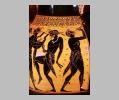
Side B: scene at right, flute player
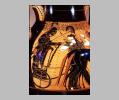
Side A: scene at left, Herakles and Iolaos in chariot led by Athena
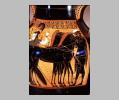
Side A: scene at right, horses
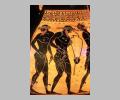
Side B: scene at left, barbiton player

Side B: scene at center, kithara player
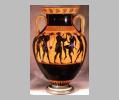
Overview: side B
| Collection: | Munich, Antikensammlungen |
| Summary: | Side A: Herakles and Iolaos in chariot, with Athena and Hermes |
| Ware: | Attic Black Figure |
| Painter: | Attributed to the Leagros Group |
| Context: | From Vulci |
| Date: | ca. 510 BC - ca. 500 BC |
| Dimensions: | H. 0.67 m. |
| Primary Citation: | |
| Shape: | Amphora |
| Beazley Number: | 302085 |
| Region: | Etruria |
| Period: | Late Archaic |
Decoration Description:
Side A: Herakles and Iolaos in chariot with Athena and Hermes. At the left of the composition, Herakles and Iolaos are mounted in the car of the chariot. The figure of Iolaos is almost completely covered by that of Herakles placed in the foreground. Only Iolaos' Corinthian helmet with high crest and his arms holding the reins, and a kentron and club in his right hand are clearly visible. Herakles wears a short chiton, the lionskin with the head drawn up over his own, a mantle over one arm. He carries a spear in his right hand. Athena stands in the middle of the composition with her lower body obscured by the horses of the quadriga. Her torso is frontal and she looks at Herakles on the left. She wears a snaky aegis and a helmet with a tall crest. She holds a spear in her right hand and gestures with her left. Her shield is seen in profile view propped against her side under the horses. At the right of the composition Hermes stands facing left at the head of the team, carrying the kerykeion. He is wrapped in a mantle and also wears boots and a petasos. All figures are labelled.
Scenes of Herakles in a chariot are very popular in the last quarter of the sixth century. Often, if Athena is driving the chariot, such scenes are interpreted as the Apotheosis of Herakles. However, with scenes such as the one on this vase where Iolaos drives and Athena merely looks on it is unclear whether one should interpret the scene as an allusion to a specific journey.
Side B: Komos. Five bearded, wreathed komasts wearing tainia around their necks dance and play music. The figure at the left, wearing only boots, moves to the right leaning forward slightly, while looking back over his shoulder. The figure next to him on the right also moves to the right, singing and playing a barbiton. This figure and the other three figures to the right all wear a sort of loincloth. The figure in the middle of the composition faces right with his head thrown back, playing a kithara. As well as the loincloth, this figure carries a small mantle over his left arm and wears boots. The figure second from the right dances, sings, and plays krotala. He faces left toward the kithara player. At the right of the composition another figure wearing boots moves to the right with his head thrown back, playing the double flute. All figures are labelled.
Inscriptions:
On Side A, the figures are labelled
On Side B, the figures are labelled from left:
Graffiti:
Graffito under foot,
Collection History:
Once in the Canino collection.
Sources Used: